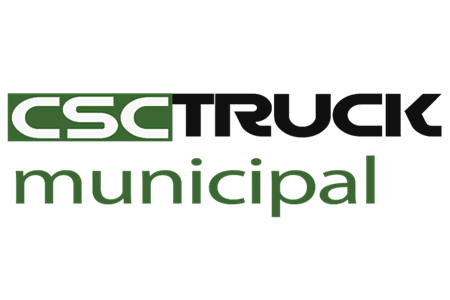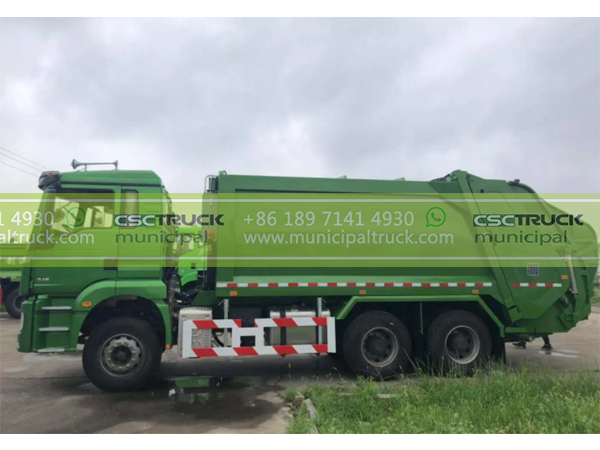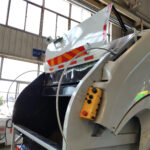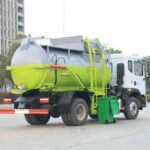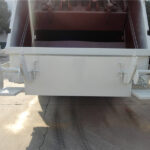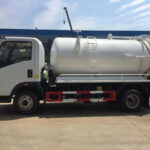Navigating the Asphalt Jungle of Waste Collection
In the intricate ecosystem of urban waste management, where narrow streets intersect with high-density housing, commercial corridors, and relentless traffic, the choice between Rear Loader Garbage Trucks and Side Loader Garbage Trucks transcends mere preference—it becomes a critical operational determinant impacting efficiency, cost, safety, and resident satisfaction. Municipalities and private waste haulers alike face the persistent challenge of optimizing collection routes within spatial and temporal constraints, requiring a nuanced understanding of how each truck’s design philosophy aligns with specific urban typographies. While the rear loader embodies traditional brute-force compaction capability suited for certain environments, the side loader represents a leap toward automation and spatial economy, yet neither functions as a universal solution; rather, their deployment demands a granular analysis of street layouts, waste generation patterns, labor availability, and long-term fleet sustainability goals.
The Case for Rear Loader Garbage Trucks – Density, Versatility, and Bulk Handling
The Workhorse of High-Volume, Mixed-Stream Environments
Rear Loader Garbage Trucks excel in scenarios demanding high-volume waste processing and operational flexibility, particularly where manual handling or irregular containerization is prevalent. Their fundamental design—centered on a rear hydraulic hopper and powerful compacting mechanism—provides distinct advantages:
- Superior Compaction Efficiency: Equipped with robust hydraulic rams that exert tremendous force on waste within the hopper before transferring it into the main body, these trucks achieve significantly higher payload densities than most side loaders, translating into fewer trips to disposal sites and maximizing the value of each route cycle in neighborhoods generating substantial volumes of refuse, such as dense apartment complexes, commercial districts with restaurants and retail outlets, or event venues producing unpredictable waste surges requiring immediate processing capacity.
- Container Agnosticism: Unlike side loaders, which typically require standardized wheeled carts compatible with automated lifting arms, rear loaders accommodate almost any container type, from loose bags and bulky items dumped manually by collection crews to commercial dumpsters lifted via rear-mounted forks; this versatility proves indispensable in older urban cores lacking uniform cart infrastructure, areas with significant illegal dumping requiring cleanup, or mixed-use zones where businesses use varied dumpster sizes incapable of integration with automated side loader arms.
- Bulk Item Handling Capability: The open-hopper design readily accepts oversized items like furniture, appliances, or construction debris that would jam or exceed the weight limits of automated side loader mechanisms, making rear loaders the default solution for municipalities offering bulky waste collection programs or operating in neighborhoods undergoing frequent renovation where large, irregular items frequently appear curbside, eliminating the need for secondary specialized collection runs that inflate operational costs.
The Rise of the Side Loader Garbage Truck – Automation, Speed, and Spatial Economy
Precision Engineering for Repetitive, Standardized Collection
Side Loader Garbage Trucks, particularly Automated Side Loaders (ASLs) and Semi-Automated Side Loaders (SSLs), redefine efficiency in settings characterized by standardized waste containers and spatial limitations, leveraging automation to enhance speed and safety:
- Unmatched Collection Speed per Stop: By utilizing a driver-operated or joystick-controlled hydraulic arm that grabs, lifts, empties, and returns standardized wheeled carts in a single fluid motion—often in under 20 seconds—side loaders drastically reduce collection time per household compared to the manual labor-intensive process of rear loaders; this efficiency compounds significantly on long routes with hundreds of stops, enabling crews to complete more pickups per shift or shorten overall route durations in sprawling suburban-style neighborhoods within city limits.
- Enhanced Maneuverability in Constricted Spaces: The absence of a rear hopper and compact arm design allows side loaders to operate effectively on narrow residential streets, cul-de-sacs, and alleys where rear loaders struggle to position without blocking traffic or requiring complex multi-point turns; the driver often remains seated while operating the arm, minimizing the need for the truck to reposition after each stop, thereby reducing fuel consumption, wear on brakes and tires, and traffic disruption in tightly packed historic districts or labyrinthine housing developments.
- Labor Optimization and Injury Reduction: Automation dramatically reduces manual labor requirements—ASLs often operate with just a driver, eliminating one or more manual laborers per truck—directly lowering payroll costs and workers’ compensation claims associated with repetitive lifting injuries; this addresses chronic industry labor shortages and enhances workforce sustainability, especially in regions with aging sanitation crews or stringent workplace safety regulations mandating reduced physical strain.
Operational Impacts – Traffic, Terrain, and Time Sensitivity
Evaluating Contextual Constraints on Urban Pavement
The urban fabric imposes unique operational stresses influencing truck selection, demanding careful assessment of route-specific challenges:
- Traffic Flow and Congestion Mitigation: Rear loaders, with their need for frequent stops where crew members exit the vehicle and manually handle waste, often require longer stationary periods per pickup, potentially exacerbating traffic congestion on busy arterial roads during peak hours; side loaders, completing stops faster with the driver typically remaining in the cab, minimize stationary time, reducing their footprint in high-traffic corridors and enhancing flow, a critical factor in cities prioritizing traffic management and reducing idling emissions.
- Terrain and Gradient Handling: Steep inclines common in cities like San Francisco or Seattle pose distinct challenges; rear loaders carry their compacted load lower and centered, offering stability advantages on hills, whereas side loaders, especially when the lifting arm is extended with a full cart, experience a higher center of gravity, increasing rollover risk on severe slopes unless equipped with specialized stabilizers—making rear loaders the default choice for consistently hilly urban terrain.
- Route Density and Stop Frequency: High-density routes with stops every 50-100 feet (common in rowhouse neighborhoods) favor the rapid-fire operation of side loaders, maximizing their time-saving automation benefits; conversely, routes with fewer, bulkier stops (e.g., large apartment complexes with central dumpsters or commercial strips with shared containers) better leverage the rear loader’s high-volume compaction capability and dumpster-handling versatility, rendering the speed-per-stop advantage of side loaders less impactful.
Labor, Safety, and Workforce Dynamics
The Human Factor in Waste Collection Machinery
Labor availability, cost structures, and safety protocols profoundly shape the feasibility of each truck type:
- Crew Size and Cost Structures: Rear loaders traditionally require a three-person crew (driver plus two loaders), significantly increasing labor costs (often 60-70% of total operating expenses) compared to ASLs operating with a single driver; municipalities facing budget constraints or persistent driver shortages may find the transition to automated side loaders financially compelling despite higher upfront truck costs, while unions or regions with abundant labor might prioritize rear loaders to maintain crew sizes.
- Worker Safety and Ergonomics: Manual lifting of heavy, awkward bins exposes rear loader crews to high risks of musculoskeletal injuries, slips, falls, and exposure to hazardous materials; ASLs virtually eliminate these risks by keeping operators safely enclosed within the cab, dramatically lowering injury rates and associated costs—a key consideration under evolving occupational safety regulations and rising workers’ compensation premiums.
- Training and Operational Complexity: Operating a side loader’s hydraulic arm demands specific joystick control proficiency and spatial awareness training for drivers, requiring investment in simulator-based or on-road instruction programs; rear loader operations, while physically demanding, involve less technical skill for the loaders (though safe dumping procedures remain critical), potentially easing recruitment in transient labor markets.
Resident Experience and Infrastructure Compatibility
Aligning Technology with Community Realities
Public acceptance and existing infrastructure heavily influence successful implementation:
- Cart Standardization and Storage Requirements: The effectiveness of ASLs hinges on universal adoption of compatible wheeled carts by residents. This requires substantial upfront investment by the municipality or hauler in cart distribution and ongoing management of replacements/damaged units. It also assumes residents have adequate space (driveways, side yards) to store carts between collections—a challenge in dense urban cores with limited private outdoor space or multi-family dwellings with shared alleys. Rear loaders impose no such standardization demands, accommodating diverse set-outs.
- Noise and Aesthetic Considerations: Side loader arms generate distinct hydraulic whines during operation, potentially causing early-morning noise complaints in quiet residential zones, whereas rear loader compaction cycles produce loud, intermittent crushing sounds; the visual impact differs too—side loaders appear more “high-tech,” potentially enhancing public perception of modernization, while rear loaders might evoke associations with older, noisier collection methods despite their utility.
- Set-Out Precision and Alley Constraints: ASLs require carts placed precisely curbside with clearance for the robotic arm (typically 2-3 feet from obstacles like parked cars, trees, or poles). Inconsistent placement leads to missed pickups or manual intervention, negating automation benefits. Rear loaders offer greater tolerance for varied set-out positions, especially crucial in alley-based collection systems where space is chaotic and carts may be placed irregularly behind homes.
Strategic Deployment – A Framework for Urban Fleet Optimization
Matching Truck DNA to Neighborhood DNA
The optimal urban fleet integrates both rear and side loader garbage trucks strategically, guided by a systematic assessment of neighborhood characteristics:
- Prioritize Side Loaders (ASL/SSL) For:
- Suburban-Style Urban Neighborhoods: Areas with single-family homes, wider streets, consistent curbside cart placement, and lower traffic density, where rapid automated collection maximizes route coverage.
- Labor-Scarce Regions: Cities facing acute driver or loader shortages benefit from reduced crew requirements.
- Safety-Critical Zones: Routes with histories of crew injuries or demanding strict OSHA compliance.
- Prioritize Rear Loaders For:
- High-Density Mixed-Use Corridors: Downtown cores, dense apartment zones, and commercial strips requiring high compaction, bulky item handling, and dumpster servicing.
- Historic/Difficult Terrain Areas: Narrow alleys, steep hills (where stability trumps automation), or areas with poor cart standardization.
- Bulk & Special Collection Routes: Dedicated runs for yard waste, furniture, or post-event cleanup where load variability is extreme.
- Hybrid Solutions & Future-Proofing: Many municipalities deploy semi-automated side loaders (SSLs), where a single crew member rolls standardized carts to the curb for mechanical lifting, blending some labor savings with rear loader-like flexibility in tighter spaces. Advances in AI and sensor technology are enabling “smart” garbage truck systems—side loaders with enhanced obstacle detection for imperfect set-outs, or rear loaders with semi-automated bin tippers. Fleet managers must also evaluate Total Cost of Ownership (TCO)—factoring in fuel efficiency (often favoring newer side loaders), maintenance complexity (hydraulic arms vs. compaction rams), disposal frequency (compaction efficiency vs. route speed), and resale value. Ultimately, the most effective municipal truck strategy involves continuous data-driven route auditing, resident feedback integration, and flexibility to adapt the fleet mix as neighborhoods evolve and new technologies emerge, ensuring every street benefits from the right tool for the job.
